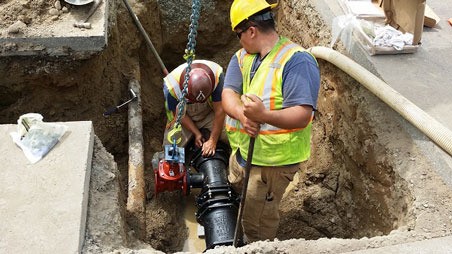City of Kent water and sewer rates are going up next year and beyond to help maintain and operate each system.
The City Council voted 7-0 on Aug. 16 to approve the new rates that include a cost-of-living increase each year tied to the regional consumer price index to help cover ongoing cost increases to repair and upgrade systems.
The plan also imposes a new monthly fee for property owners with dedicated fire lines for sprinkler systems.
The new water and fire line rates will bring in an estimated $18.9 million in city revenue next year, an $1.6 million increase over this year, according to city staff. The higher sewer rates, including King County’s Metro fee, will bring in an estimated $29.3 million in 2017, an $2.2 million increase from this year.
City Public Works staff worked with the council for more than two years to come up with a plan to help cover the estimated $4.5 million capital projects needed per year in the water system and an estimated $5 million per year of sewer system projects.
Residential water rates will jump in 2017 to $39.95 per month from $37.83 for the average customer with a 3/4-inch meter and who uses 700 cubic feet. That rate will increase each year based on the consumer price index with increases capped at 2.4 percent until 2023, when the hikes will follow the CPI without any cap.
Commercial water rates will go up to $45.90 from $30.31 for 3/4-inch meters and 700 cubic feet of use; to $70.86 from $60.09 for 1-inch meters and 1,000 cubic feet; and to $127.26 from $94.61 per month for those with 1.5-inch meters who use 1,500 cubic feet.
“It is our absolute primary responsibility to make sure our residents and utility customers have a consistent healthy supply for water and that the sewer utility does what it needs to do,” Councilwoman Dana Ralph said prior to the vote. “Those are two surprises nobody wants to wake up to. We need to maintain the system and it takes money to do that.
“If we can maintain things as we go, it is consistently less expensive than to try to fix things after they are broken. These new rates will allow us to do that.”
The combined Metro and city sewer rates will jump 8 percent in 2017 to $66.38 from $61.46 per month. The city will raise its rate next year to $22.16 from from $19.43 month. Metro, whose rates are overseen by the King County Council, plans a jump to $44.22 from $42.03. The city sewer rate will jump each year and reach an estimated $32.62 per month in 2022 under the plan.
Councilman Dennis Higgins said it makes sense to annually raise water and sewer rates.
“The laddering for inflation means future councils won’t need to come back year by year or five years from now and tackle this,” Higgins said. “If we didn’t put that in there, the buying power of the rate structure would erode year by year through inflation. We’re enabling future councils not to have to worry about this for the foreseeable future.”
Paul Scott, city public works accounting manager, told the council staff looked at a goal to develop and implement a sustainable funding model for water supply and sewer supply by examining revenue, capital needs and rate structure.
“We have 211 miles of sewer pipes, and 33 percent of those are over 40 years old,” Scott said. “Forty-year-old pipe becomes problematic and there is a greater chance of failure. We put a model together because we need enough money to replace some of older sewer lines.”
A new monthly fee will charge people with dedicated fire lines for sprinkler systems. They pay no fees now. The cost will be $2.75 per month. There will be n charge for water used during an incident. Most neighboring cities, except Auburn, levy the fee, according to city staff.
“The businesses that have fire lines now and have sprinkler systems were getting a free ride,” Councilwoman Tina Budell said. “I feel better we all are paying our fair share.”
Water customers no longer will pay a winter and summer rate. The city raises rates in the summer but starting in 2017 the rate will not change during the year.
“We are going to get rid of winter-summer rates to help residents with budgeting and for ease of not having a lot higher rate in summer than they do in winter,” said Kristin Lykken, public works financial analyst. “It also will help our staff not having to switch the rates and taking phone calls about it (higher summer fees).”
The new plan raises the breaking point for a higher rate to 800 cubic feet from 700 cubic feet. Most residential customers use less than 800 cubic feet per month.
Rates will go up each year automatically rather than the council having to look at rates and deciding whether to raise them or not.
“We should have been losing sleep over the fact that we have been under-funding our capital investments in our critical utilities for quite some time,” Higgins said. “We haven’t done what we’ve needed to do to all the systems to reinvest in themselves so we know they will be robust and be well maintained, and in a crisis we will have the ability to fix our systems.”
Talk to us
Please share your story tips by emailing editor@kentreporter.com.
To share your opinion for publication, submit a letter through our website https://www.kentreporter.com/submit-letter/. Include your name, address and daytime phone number. (We’ll only publish your name and hometown.) Please keep letters to 300 words or less.

